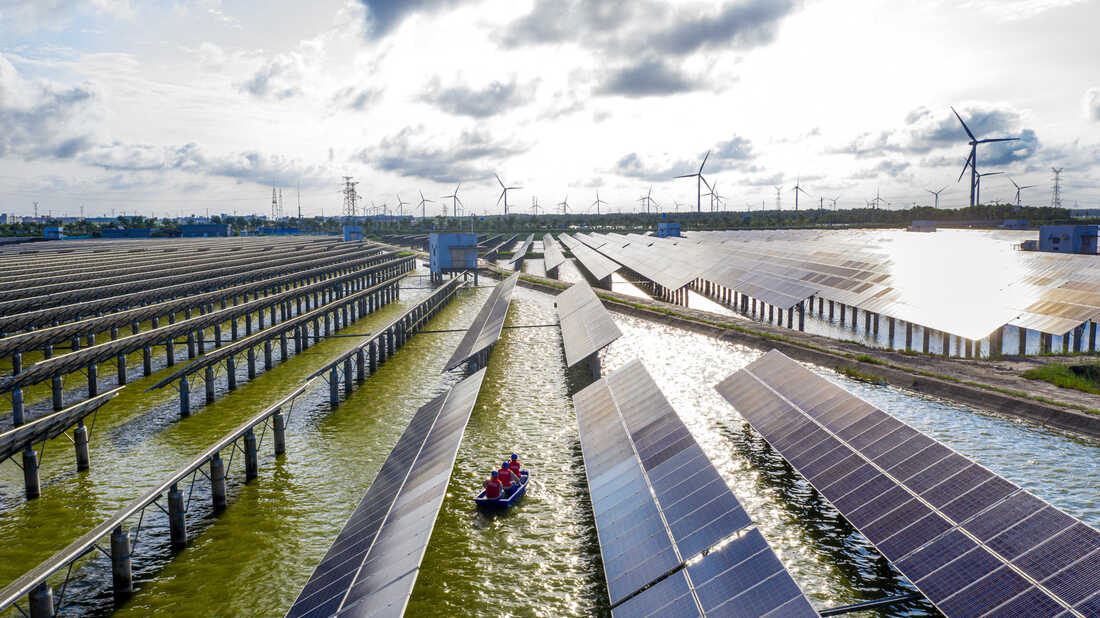Is There Any Hope For Climate Change

Electric workers check solar panels at a photovoltaic power station congenital in a fishpond in Haian in China's eastern Jiangsu province. STR/AFP via Getty Images hide caption
toggle caption
STR/AFP via Getty Images

Electrical workers check solar panels at a photovoltaic ability station congenital in a fishpond in Haian in China'south eastern Jiangsu province.
STR/AFP via Getty Images
As the world's meridian climate scientists released a written report full of warnings this week, they kept insisting that the world still has a risk to avert the worst furnishings of climatic change.
"It is still possible to forestall most of the dire impacts, but information technology really requires unprecedented, transformational modify," said Ko Barrett, vice chair of the Intergovernmental Console on Climate change. "The idea that there still is a pathway forwards, I recall, is a signal that should requite us some promise."
That hopeful pathway, in which dangerous changes to the globe's climate somewhen cease, is the product of giant computer simulations of the world economy. They're called integrated assessment models. There are half a dozen major versions of them: four adult in Europe, one in Nippon, and i in the U.South., at Pacific Northwest National Laboratory.
"What we by and large are doing, is trying to explore what is needed to come across the Paris goals." says Detlef van Vuuren, at the Netherlands Environmental Assessment Agency, which developed one of the models.
How to cut greenhouse gas emissions to goose egg in forty years
World leaders agreed in Paris to limit global warming to less than 2 degrees Celsius (iii.6 degrees Fahrenheit). The planet has already warmed about 1 degree Celsius, compared to pre-industrial levels.
Meeting that goal volition mean cut net greenhouse gas emissions to zero within about 40 years. It would require profound changes; so profound, information technology's not immediately clear that it'southward fifty-fifty possible.
That's why van Vuuren and his colleagues turned to their computer models for assist. "How is it possible to get to zero emissions?" he says. "That's for transport, that's for housing, that's for electricity."
Each of these models starts with data almost current sources of greenhouse emissions. They include cars and buses, auto rickshaws, airplanes, power plants, home furnaces and rice paddies. The models also include assumptions about international trade, prices, and the costs of new technologies.
Then the scientists strength their virtual worlds to change course, by introducing limits on greenhouse emissions. The models so try to satisfy that requirement in the about cost-effective way, as long as it'southward technologically viable and doesn't sew together confronting limits like the supply of land or other natural resources.
The adept news is that the models found a way to meet that target, at least in scenarios where world governments were inclined to cooperate in meeting their Paris commitments. In fact, according to Keywan Riahi, at the International Institute for Applied Systems, in Republic of austria, they found multiple paths to naught carbon.
"The models tell us that there are, starting time of all, culling pathways possible; that there are choices available to the decision-maker," he says.
Different models, using different assumptions, arrive at contrasting visions of the future earth. But they're all dramatically different from the situation today.
Some models evidence people responding to higher free energy prices or authorities regulations by irresolute their lifestyle. They move to more than energy-saving houses, and requite up their cars in favor of a new and better kind of public transit. In addition to traditional bus lines, democratic vehicles reply similar Uber — taking people where they need to go.
Riahi likes this version best. "I'm convinced that a fundamental need-side restructuring would also lead to a improve quality of life," he says.
Other scenarios evidence people notwithstanding using enough of free energy, which in plough requires a huge heave in product of make clean electricity. It would mean 10 or xx times more than land covered with solar and wind farms, compared to now, plus more than power plants burning forest or other biofuels, outfitted with equipment to capture and shop the carbon dioxide that's released.
Politics and individuals' preferences could foil the models
Riahi is quick to point out that what happens in the models may not be feasible in real life. They don't account for political obstruction, for instance, or human preferences. People may just want to drive an expensive auto, rather than take public transit, even when the models says that option isn't economically rational.
But the models also tin be far too pessimistic, in particular nearly technological innovation. Ten years ago, van Vuuren says, they never anticipated the rise of cheap solar power. "We have been in the extremely fortunate situation that the cost of renewables has declined chop-chop in the past decade." This has made the chore of reducing carbon emissions much easier.
For all their shortcomings, though, these models remain the primary fashion that scientists and policymakers figure out options for the future. They quantify tradeoffs and consequences that may not be conspicuously credible. If countries desire to turn trees or crops into fuel, for instance, it means less land for growing food or for natural forests. Also, the models brand it clear that international cooperation is essential, with rich countries helping poorer countries to cut their emissions.
The results of the computer modeling are like fuzzy maps, pointing out routes that could aid the globe avert disaster.
Source: https://www.npr.org/2021/08/14/1027370891/climate-change-solutions-global-warming-computer-models-paris
Posted by: ballgairciand.blogspot.com


0 Response to "Is There Any Hope For Climate Change"
Post a Comment